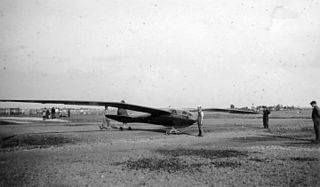Related Research Articles

The Maeda 703 was one of the first indigenous Japanese gliders, a high performance single seat aircraft which first flew in 1940. Three were built, two with gull wing wings; one of these set a national endurance record in 1941.
The CVV1 Pinguino was a single seat, high performance glider designed and built in Italy in the mid-1930s, the first of a series of gliders from the Milan Polytechnic. It did not go into production.
The Teichfuss Supergrifo or Super Grifo was an Italian competition glider designed by Luigi Teichfuss and flown in 1935. Only one was built.

The RRG Fafnir 2 São Paulo, named after the legendary dragon and the Brazilian city which partially financed it, was a single seat German high performance glider designed by Alexander Lippisch. It set a new world distance record in 1934 and won the 1937 International Gliding Championships.

The IFIL-Reghin RG-5 Pescăruș or CIL Reghin RG-5 Pescăruș was a Romanian single seat sailplane built in the 1950s. Twenty six were constructed for gliding clubs.
The DFS Sperber Senior was a competition sailplane designed and built in Germany in 1936. During 1937 the sole example visited the United States and scored highest in the US National Soaring Competition.
The DFS Sperber Junior was a competition sailplane designed for Hanna Reitsch and built in Germany in 1936.
The Schneider Grunau 7 Moazagotl was a high-performance sailplane designed in Germany in 1933 specifically for fast, long distance flying using strong thermals. In 1937 it came second in the first World Gliding Championships, having previously made a flight of 300 km (186 mi).
The Musger Mg 9 was a tandem two seat glider built in Austria in the mid-1930s. It broke both world and national records.

The Czerwiński CW 5bis was a Polish high performance sailplane, produced and developed between 1933 and 1935. It set several national records, competed at both national and international level and remained a Polish gliding club mainstay until the outbreak of World War II.

The PWS-102 Rekin was a progressive development of the PWS-101, intended for cross-country flights. The prototype flew in an international contest in 1939 and the first of a projected production series was flown before the start of World War II.
The PWS-103 was a high performance, Polish 15 m span sailplane developed from the longer-span PWS-102 just before World War II.

The Grzeszczyk SG-3 was a Polish single-seat, high performance sailplane first flown in 1933. Between 1934 and 1937 it was Poland's most successful competitor and record setter; about twenty-five were completed.

The Warsztaty Szybowcowe SG-7 was a Polish high performance, single seat sailplane. Two prototypes flew in 1937 but, outperformed by their contemporaries, no more were built.

The Rubik R-03 Szittya I was a Hungarian single-seat sailplane flown in the late 1930s. The design was developed through three improving variants. though only one of each was built.
The Jancsó-Szokolay M22 was a Hungarian single-seat sailplane first flown in 1937. Twenty were built and the type set several national records. Some remained in service up to about 1953.

The Rubik R-08 Pilis was a Hungarian single-seat, advanced training glider first flown in 1939. It was very successful; 269 were built in batches, the first starting in 1939 and the last in 1956.

The Spalinger S.21 is a Swiss two-seat trainer glider flown in the late 1930s. They were heavily used as trainers but also set many new Swiss national records in the two-seat category.
The Spalinger S.18 is a Swiss 1930s performance sailplane. Several variants were built and the S.18 dominated Swiss contests and set records for nearly a decade. Many were active into the 1960s and four remain on the Swiss register.

The Spalinger S.15 is a Swiss, single-seat training glider first flown in 1930. There were several variants, of which only the 1934 S.15K was serially produced. One restored example remains active in 2019.
References
- 1 2 3 4 Simons, Martin (2006). Sailplanes 1920-1945 (2nd revised ed.). Königswinter: EQIP Werbung & Verlag GmbH. pp. 246, 248. ISBN 3 9806773 4 6.
- ↑ "The Soviet Record Breakers" . Retrieved 24 August 2019.
- 1 2 "Groshev GN-7" . Retrieved 24 August 2019.